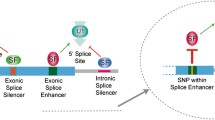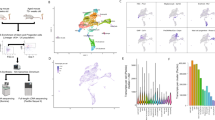Abstract
Haematopoiesis is a complex process regulated at various levels facilitating rapid responses to external factors including stress, modulation of lineage commitment and terminal differentiation of progenitors. Although the transcription program determines the RNA pool of a cell, various mRNA strands can be obtained from the same template, giving rise to multiple protein isoforms. The majority of variants and isoforms co-occur in normal haematopoietic cells or are differentially expressed at various maturity stages of progenitor maturation and cellular differentiation within the same lineage or across lineages. Genetic aberrations or specific cellular states result in the predominant expression of abnormal isoforms leading to deregulation and disease. The presence of upstream open reading frames (uORF) in 5′ untranslated regions (UTRs) of a transcript, couples the utilization of start codons with the cellular status and availability of translation initiation factors (eIFs). In addition, tissue-specific and cell lineage-specific alternative promoter use, regulates several transcription factors producing transcript variants with variable 5′ exons. In this review, we propose to give a detailed account of the differential isoform formation, causing haematological malignancies.


Similar content being viewed by others
References
Black DL. Mechanisms of alternative pre-messenger RNA splicing. Annu Rev Biochem. 2003;72:291–336.
Hui J. Regulation of mammalian pre-mRNA splicing. Sci China C Life Sci. 2009;52(3):253–60.
Mischak H, Pierce JH, et al. Phorbol ester-induced myeloid differentiation is mediated by protein kinase C-alpha and -delta and not by protein kinase C-beta II, -epsilon, -zeta, and -eta. J Biol Chem. 1993;268(27):20110–5.
Redig AJ, Platanias LC. The protein kinase C (PKC) family of proteins in cytokine signaling in hematopoiesis. J Interferon Cytokine Res. 2007;27(8):623–36.
Feng Y, Wen J, et al. p38 Mitogen-activated protein kinase and hematologic malignancies. Arch Pathol Lab Med. 2009;133(11):1850–6.
Ayoubi TA, Van De Ven WJ. Regulation of gene expression by alternative promoters. FASEB J. 1996;10(4):453–60.
Cooper SJ, Trinklein ND, et al. Comprehensive analysis of transcriptional promoter structure and function in 1% of the human genome. Genome Res. 2006;16(1):1–10.
Duan ZJ, Fang X, et al. Developmental specificity of recruitment of TBP to the TATA box of the human gamma-globin gene. Proc Natl Acad Sci USA. 2002;99(8):5509–14.
Tan JS, Mohandas N, et al. High frequency of alternative first exons in erythroid genes suggests a critical role in regulating gene function. Blood. 2006;107(6):2557–61.
Pozner A, Goldenberg D, et al. Transcription-coupled translation control of AML1/RUNX1 is mediated by cap- and internal ribosome entry site-dependent mechanisms. Mol Cell Biol. 2000;20(7):2297–307.
Barrett LW, Fletcher S, et al. Regulation of eukaryotic gene expression by the untranslated gene regions and other non-coding elements. Cell Mol Life Sci. 2012;69(21):3613–34.
Blazquez-Domingo M, Grech G, et al. Translation initiation factor 4E inhibits differentiation of erythroid progenitors. Mol Cell Biol. 2005;25(19):8496–506.
Arce L, Yokoyama NN, et al. Diversity of LEF/TCF action in development and disease. Oncogene. 2006;25(57):7492–504.
Calkhoven CF, Muller C, et al. Translational control of C/EBPalpha and C/EBPbeta isoform expression. Genes Dev. 2000;14(15):1920–32.
Medenbach J, Seiler M, et al. Translational control via protein-regulated upstream open reading frames. Cell. 2011;145(6):902–13.
Grech G, von Lindern M. The role of translation initiation regulation in haematopoiesis. Comp Funct Genomics. 2012;2012:576540.
McClelland S, Shrivastava R, et al. Regulation of translational efficiency by disparate 5′ UTRs of PPARgamma splice variants. PPAR Res. 2009;2009:193413.
Challen GA, Goodell MA. Runx1 isoforms show differential expression patterns during hematopoietic development but have similar functional effects in adult hematopoietic stem cells. Exp Hematol. 2010;38(5):403–16.
Gomez-del Arco P, Kashiwagi M, et al. Alternative promoter usage at the Notch1 locus supports ligand-independent signaling in T cell development and leukemogenesis. Immunity. 2010;33(5):685–98.
Li TW, Ting JH, et al. Wnt activation and alternative promoter repression of LEF1 in colon cancer. Mol Cell Biol. 2006;26(14):5284–99.
Pan Q, Shai O, et al. Deep surveying of alternative splicing complexity in the human transcriptome by high-throughput sequencing. Nat Genet. 2008;40(12):1413–5.
Lynch KW. Regulation of alternative splicing by signal transduction pathways. Adv Exp Med Biol. 2007;623:161–74.
Grosso AR, Gomes AQ, et al. Tissue-specific splicing factor gene expression signatures. Nucl Acids Res. 2008;36(15):4823–32.
Fairbrother WG, Yeh RF, et al. Predictive identification of exonic splicing enhancers in human genes. Science. 2002;297(5583):1007–13.
Faustino NA, Cooper TA. Pre-mRNA splicing and human disease. Genes Dev. 2003;17(4):419–37.
Yoshida K, Sanada M, et al. Frequent pathway mutations of splicing machinery in myelodysplasia. Nature. 2011;478(7367):64–9.
Liu HX, Cartegni L, et al. A mechanism for exon skipping caused by nonsense or missense mutations in BRCA1 and other genes. Nat Genet. 2001;27(1):55–8.
Eiring AM, Harb JG, et al. miR-328 functions as an RNA decoy to modulate hnRNP E2 regulation of mRNA translation in leukemic blasts. Cell. 2010;140(5):652–65.
Chao MP, Seita J, et al. Establishment of a normal hematopoietic and leukemia stem cell hierarchy. Cold Spring Harb Symp Quant Biol. 2008;73:439–49.
Renstrom J, Kroger M, et al. How the niche regulates hematopoietic stem cells. Chem Biol Interact. 2010;184(1–2):7–15.
Yoon D, Ponka P, et al. Hypoxia. 5. Hypoxia and hematopoiesis. Am J Physiol Cell Physiol. 2011;300(6):C1215–22.
Calligaris R, Bottardi S, et al. Alternative translation initiation site usage results in two functionally distinct forms of the GATA-1 transcription factor. Proc Natl Acad Sci USA. 1995;92(25):11598–602.
Ahmed N, Howard L, et al. Early endodermal expression of the Xenopus Endodermin gene is driven by regulatory sequences containing essential Sox protein-binding elements. Differentiation. 2004;72(4):171–84.
Hollanda LM, Lima CS, et al. An inherited mutation leading to production of only the short isoform of GATA-1 is associated with impaired erythropoiesis. Nat Genet. 2006;38(7):807–12.
Hong W, Nakazawa M, et al. FOG-1 recruits the NuRD repressor complex to mediate transcriptional repression by GATA-1. EMBO J. 2005;24(13):2367–78.
Snow JW, Orkin SH. Translational isoforms of FOG1 regulate GATA1-interacting complexes. J Biol Chem. 2009;284(43):29310–9.
Calkhoven CF, Muller C, et al. Translational control of SCL-isoform expression in hematopoietic lineage choice. Genes Dev. 2003;17(8):959–64.
Wek RC, Jiang HY, et al. Coping with stress: eIF2 kinases and translational control. Biochem Soc Trans. 2006;34(Pt 1):7–11.
Pabst T, Mueller BU, et al. AML1-ETO downregulates the granulocytic differentiation factor C/EBPalpha in t(8;21) myeloid leukemia. Nat Med. 2001;7(4):444–51.
Ren X, Gomez GA, et al. Scl isoforms act downstream of etsrp to specify angioblasts and definitive hematopoietic stem cells. Blood. 2010;115(26):5338–46.
Wouters BJ, Lowenberg B, et al. Double CEBPA mutations, but not single CEBPA mutations, define a subgroup of acute myeloid leukemia with a distinctive gene expression profile that is uniquely associated with a favorable outcome. Blood. 2009;113(13):3088–91.
Cleaves R, Wang QF, et al. C/EBPalphap30, a myeloid leukemia oncoprotein, limits G-CSF receptor expression but not terminal granulopoiesis via site-selective inhibition of C/EBP DNA binding. Oncogene. 2004;23(3):716–25.
Cornillet-Lefebvre P, Cuccuini W, et al. Constitutive phosphoinositide 3-kinase activation in acute myeloid leukemia is not due to p110delta mutations. Leukemia. 2006;20(2):374–6.
Beghini A, Peterlongo P, et al. C-kit mutations in core binding factor leukemias. Blood. 2000;95(2):726–7.
Grech G, Blazquez-Domingo M, et al. Igbp1 is part of a positive feedback loop in stem cell factor-dependent, selective mRNA translation initiation inhibiting erythroid differentiation. Blood. 2008;112(7):2750–60.
Neviani P, Santhanam R, et al. FTY720, a new alternative for treating blast crisis chronic myelogenous leukemia and Philadelphia chromosome-positive acute lymphocytic leukemia. J Clin Invest. 2007;117(9):2408–21.
Pinder JC, Chung A, et al. Membrane attachment sites for the membrane cytoskeletal protein 4.1 of the red blood cell. Blood. 1993;82(11):3482–8.
Rebollo A, Schmitt C. Ikaros, Aiolos and Helios: transcription regulators and lymphoid malignancies. Immunol Cell Biol. 2003;81(3):171–5.
Dumortier A, Kirstetter P, et al. Ikaros regulates neutrophil differentiation. Blood. 2003;101(6):2219–26.
Ronni T, Payne KJ, et al. Human Ikaros function in activated T cells is regulated by coordinated expression of its largest isoforms. J Biol Chem. 2007;282(4):2538–47.
Sun L, Heerema N, et al. Expression of dominant-negative and mutant isoforms of the antileukemic transcription factor Ikaros in infant acute lymphoblastic leukemia. Proc Natl Acad Sci USA. 1999;96(2):680–5.
Meleshko AN, Movchan LV, et al. Relative expression of different Ikaros isoforms in childhood acute leukemia. Blood Cells Mol Dis. 2008;41(3):278–83.
Davuluri RV, Suzuki Y, et al. The functional consequences of alternative promoter use in mammalian genomes. Trends Genet. 2008;24(4):167–77.
Yamanaka R, Kim GD, et al. CCAAT/enhancer binding protein epsilon is preferentially up-regulated during granulocytic differentiation and its functional versatility is determined by alternative use of promoters and differential splicing. Proc Natl Acad Sci USA. 1997;94(12):6462–7.
Pischedda C, Cocco S, et al. Isolation of a differentially regulated splicing isoform of human NF-E2. Proc Natl Acad Sci USA. 1995;92(8):3511–5.
Toki T, Itoh J, et al. Abundant expression of erythroid transcription factor P45 NF-E2 mRNA in human peripheral granulocytes. Biochem Biophys Res Commun. 1996;219(3):760–5.
Levanon D, Groner Y. Structure and regulated expression of mammalian RUNX genes. Oncogene. 2004;23(24):4211–9.
Brewer A, Gove C, et al. The human and mouse GATA-6 genes utilize two promoters and two initiation codons. J Biol Chem. 1999;274(53):38004–16.
Ito E, Toki T, et al. Erythroid transcription factor GATA-1 is abundantly transcribed in mouse testis. Nature. 1993;362(6419):466–8.
Minegishi N, Ohta J, et al. Alternative promoters regulate transcription of the mouse GATA-2 gene. J Biol Chem. 1998;273(6):3625–34.
Pan X, Minegishi N, et al. Identification of human GATA-2 gene distal IS exon and its expression in hematopoietic stem cell fractions. J Biochem. 2000;127(1):105–12.
Banville D, Stocco R, et al. Human protein tyrosine phosphatase 1C (PTPN6) gene structure: alternate promoter usage and exon skipping generate multiple transcripts. Genomics. 1995;27(1):165–73.
Ma XZ, Jin T, et al. Abnormal splicing of SHP-1 protein tyrosine phosphatase in human T cells. Implications for lymphomagenesis. Exp Hematol. 2003;31(2):131–42.
Speletas M, Argentou N, et al. Survivin isoform expression patterns in CML patients correlate with resistance to imatinib and progression, but do not trigger cytolytic responses. Clin Immunol. 2011;139(2):155–63.
Chang WH, Liu TC, et al. Amiloride modulates alternative splicing in leukemic cells and resensitizes Bcr-AblT315I mutant cells to imatinib. Cancer Res. 2011;71(2):383–92.
Author information
Authors and Affiliations
Corresponding author
Additional information
G. Grech, J. Pollacco, M. Portelli, K. Sacco, S. Baldacchino, and C. Saliba contributed equally.
About this article
Cite this article
Grech, G., Pollacco, J., Portelli, M. et al. Expression of different functional isoforms in haematopoiesis. Int J Hematol 99, 4–11 (2014). https://doi.org/10.1007/s12185-013-1477-7
Received:
Revised:
Accepted:
Published:
Issue Date:
DOI: https://doi.org/10.1007/s12185-013-1477-7




